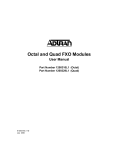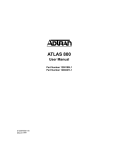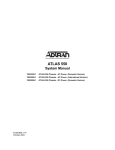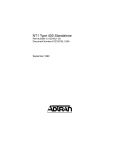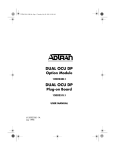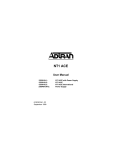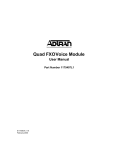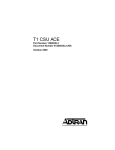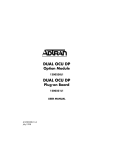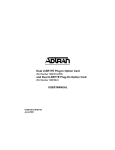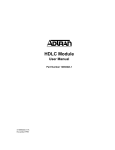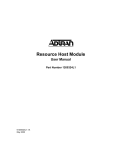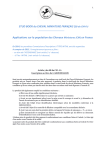Download Octal E&M Module User Manual
Transcript
Octal E&M Module User Manual Part Number 1200313L1 61200313L1-1A August 2000 901 Explorer Boulevard P.O. Box 140000 Huntsville, AL 35814-4000 (256) 963-8000 © 2000ADTRAN, Inc. All Rights Reserved. Printed in U.S.A. Federal Communications Commission (FCC) Radio Frequency Interference Statement This equipment has been tested and found to comply with the limits for a Class A digital device, pursuant to Part 15 of the FCC Rules. These limits are designed to provide reasonable protection against harmful interference when the equipment is operated in a commercial environment. This equipment generates, uses, and can radiate radio frequency energy and, if not installed and used in accordance with the instruction manual, may cause harmful interference to radio frequencies. Operation of this equipment in a residential area is likely to cause harmful interference in which case the user will be required to correct the interference at his own expense. Shielded cables must be used with this unit to ensure compliance with Class A FCC limits. Change or modifications to this unit not expressly approved by the party responsible for compliance could void the user’s authority to operate the equipment. Canadian Emissions Requirements This digital apparatus does not exceed the Class A limits for radio noise emissions from digital apparatus as set out in the interference-causing equipment standard entitled “Digital Apparatus,” ICES-003 of the Department of Communications. Cet appareil numerique respecte les limites de bruits radioelectriques applicables aux appareils numeriques de Class A prescrites dans la norme sur le materiel brouilleur: “Appareils Numeriques,” NMB-003 edictee par le Ministre des Communications. iii Limited Product Warranty ADTRAN warrants that for five (5) years from the date of shipment to Customer, all products manufactured by ADTRAN will be free from defects in materials and workmanship. ADTRAN also warrants that products will conform to the applicable specifications and drawings for such products, as contained in the Product Manual or in ADTRAN's internal specifications and drawings for such products (which may or may not be reflected in the Product Manual). This warranty only applies if Customer gives ADTRAN written notice of defects during the warranty period. Upon such notice, ADTRAN will, at its option, either repair or replace the defective item. If ADTRAN is unable, in a reasonable time, to repair or replace any equipment to a condition as warranted, Customer is entitled to a full refund of the purchase price upon return of the equipment to ADTRAN. This warranty applies only to the original purchaser and is not transferable without ADTRAN's express written permission. This warranty becomes null and void if Customer modifies or alters the equipment in any way, other than as specifically authorized by ADTRAN. EXCEPT FOR THE LIMITED WARRANTY DESCRIBED ABOVE, THE FOREGOING CONSTITUTES THE SOLE AND EXCLUSIVE REMEDY OF THE CUSTOMER AND THE EXCLUSIVE LIABILITY OF ADTRAN AND IS IN LIEU OF ANY AND ALL OTHER WARRANTIES (EXPRESSED OR IMPLIED). ADTRAN SPECIFICALLY DISCLAIMS ALL OTHER WARRANTIES, INCLUDING (WITHOUT LIMITATION), ALL WARRANTIES OF MERCHANTABILITY AND FITNESS FOR A PARTICULAR PURPOSE. SOME STATES DO NOT ALLOW THE EXCLUSION OF IMPLIED WARRANTIES, SO THIS EXCLUSION MAY NOT APPLY TO CUSTOMER. In no event will ADTRAN or its suppliers be liable to Customer for any incidental, special, punitive, exemplary or consequential damages experienced by either Customer or a third party (including, but not limited to, loss of data or information, loss of profits, or loss of use). ADTRAN is not liable for damages for any cause whatsoever (whether based in contract, tort, or otherwise) in excess of the amount paid for the item. Some states do not allow the limitation or exclusion of liability for incidental or consequential damages, so the above limitation or exclusion may not apply to Customer. Warranty and Customer Service ADTRAN will replace or repair this product within five years from the date of shipment if the product does not meet its published specification, or if it fails while in service. For detailed warranty, repair, and return information, refer to the ADTRAN Equipment Warranty and Repair and Return Policy Procedure (see the last page of this manual). A return material authorization (RMA) is required prior to returning equipment to ADTRAN. For service, RMA requests, or more information, see the last page of this manual for the toll-free contact number. iv Table of Contents List of Figures ....................................................................................................................................................vii List of Tables....................................................................................................................................................... ix Chapter 1 Introduction .............................................................................................................................. 1-1 Octal E&M Module Overview ........................................................................................................................ 1-1 Functional Description.............................................................................................................................. 1-1 Features ....................................................................................................................................................... 1-1 Physical Description .................................................................................................................................. 1-2 Chapter 2 Installation ................................................................................................................................ 2-1 Before Installing the Octal E&M Module ...................................................................................................... 2-1 Shipping Contents ..................................................................................................................................... 2-1 Installing the Octal E&M Module................................................................................................................... 2-2 Wiring ................................................................................................................................................................. 2-3 Power-Up and Initialization............................................................................................................................ 2-3 Operation Alarms ...................................................................................................................................... 2-3 Chapter 3 Operation .................................................................................................................................. 3-1 Overview ............................................................................................................................................................ 3-1 Terminal Menu Structure................................................................................................................................. 3-2 Modules Menu .................................................................................................................................................. 3-2 Slt ................................................................................................................................................................. 3-3 Type ............................................................................................................................................................ 3-3 Menu ........................................................................................................................................................... 3-4 Alarm .......................................................................................................................................................... 3-4 Test .............................................................................................................................................................. 3-4 State ............................................................................................................................................................. 3-4 Status .......................................................................................................................................................... 3-4 Online .................................................................................................................................................. 3-4 No Response ....................................................................................................................................... 3-4 Empty .................................................................................................................................................. 3-4 Offline .................................................................................................................................................. 3-5 Offline/No Response ........................................................................................................................ 3-5 Rev .............................................................................................................................................................. 3-5 Octal E&M Module Menu Options ................................................................................................................ 3-5 Info ...................................................................................................................................................................... 3-5 Part Number .............................................................................................................................................. 3-5 Serial Number ........................................................................................................................................... 3-5 Assembly Revision ................................................................................................................................... 3-5 Firmware Revision .................................................................................................................................... 3-5 Status................................................................................................................................................................... 3-5 61200313L1-1 Octal E&M Module User Manual v Table of Contents Port .............................................................................................................................................................. 3-5 Status ........................................................................................................................................................... 3-5 Inactive ................................................................................................................................................ 3-5 Disabled ............................................................................................................................................... 3-5 Idle ....................................................................................................................................................... 3-6 E-Lead Asserted ................................................................................................................................. 3-6 M-lead detected .................................................................................................................................. 3-6 Call in Progress .................................................................................................................................. 3-6 TO ......................................................................................................................................................... 3-6 Test E-Lead Open ............................................................................................................................... 3-6 Test E-Lead Closed ............................................................................................................................ 3-6 Test ....................................................................................................................................................... 3-6 Rx & Tx ABCD ........................................................................................................................................... 3-6 Test ...................................................................................................................................................................... 3-6 Test 2W ....................................................................................................................................................... 3-6 Tx ABCD .................................................................................................................................................... 3-7 1kHz Tone .................................................................................................................................................. 3-7 Loopback .................................................................................................................................................... 3-7 Configuration..................................................................................................................................................... 3-7 Port .............................................................................................................................................................. 3-7 Port Name .................................................................................................................................................. 3-7 Sig Ifce ......................................................................................................................................................... 3-8 VF Ifce ......................................................................................................................................................... 3-8 Rx Gain ....................................................................................................................................................... 3-8 Tx Gain ....................................................................................................................................................... 3-8 ATLAS 550 Features Used with Octal E&M Module .................................................................................. 3-8 Factory Restore .......................................................................................................................................... 3-8 Run Self-test ............................................................................................................................................... 3-8 Appendix A Dial Plan Interface Configuration ...................................................................................... A-1 Index ...........................................................................................................................................................Index-1 vi Octal E&M Module User Manual 61200313L1-1 List of Figures Figure 1-1. Figure 2-1. Figure 3-1. Figure 3-2. Figure 3-3. Figure A-1. Octal E&M Module ..................................................................................................................... 1-2 Installing the Octal E&M Module ............................................................................................. 2-2 Modules Menu............................................................................................................................. 3-2 Menu Tree for Octal E&M Module Menu ............................................................................... 3-3 Octal E&M Module Menu Options........................................................................................... 3-5 Dial Plan Menus ......................................................................................................................... A-1 61200313L1-1 Octal E&M Module User Manual vii List of Figures viii Octal E&M Module User Manual 61200313L1-1 List of Tables Table 2-1. Table 2-2. Table 3-1. Pinout Connection....................................................................................................................... 2-3 Trunk Circuit Connections for Various E&M Signaling Types............................................ 2-3 Test 2W Information ................................................................................................................... 3-7 61200313L1-1 Octal E&M Module User Manual ix List of Tables x Octal E&M Module User Manual 61200313L1-1 Chapter 1 Introduction OCTAL E&M MODULE OVERVIEW The Octal E&M Module is a member of the ATLAS 550 family of products. It provides eight analog voice-grade interfaces, either 2-wire or 4-wire, for use as tie-trunks using E&M signaling or as dedicated transmission only (TO) interfaces for additional data services. Functional Description The Octal E&M Module installs in any available user option slot in the ATLAS 550 chassis. Status information is available via the terminal menus, accessible through either a VT-100 terminal connected to the ATLAS 550 control port or via a Telnet session established through the Base Unit’s Ethernet port. Use the terminal menu to configure the Octal E&M Module and to download application software upgrades. Features The features of the Octal E&M Module are listed below: 61200313L1-1 • Eight voice ports • Selectable for 2-wire or 4-wire voice interface, per port • E-lead originate • E&M type I, I, III, IV, V plus TO mode, per port • E&M type V can be used for Press-To-Talk (PTT) radio applications • Resource Module connector • Hot-swappable • Flash download firmware Octal E&M Module User Manual 1-1 Chapter 1. Introduction Physical Description The Octal E&M Module plugs into any available option slot in the rear of the ATLAS 550 chassis. Figure 1-1 shows the Octal E&M Module. 1 2 3 4 5 6 7 8 500 Series OCTAL E&M Figure 1-1. Octal E&M Module The labels over the modular connectors refer to the corresponding port on the Octal E&M Module. 1-2 Octal E&M Module User Manual 61200313L1-1 Chapter 2 Installation BEFORE INSTALLING THE OCTAL E&M MODULE Carefully unpack and inspect the module for shipping damages. If you suspect damage occurred during shipping, file a claim immediately with the carrier and then contact ADTRAN Technical Support (see the last page of this manual for pertinent information). If possible, keep the original shipping container for returning the module for repair or for verification of shipping damage. Shipping Contents The ADTRAN shipment includes the following items: 61200313L1-1 • Octal E&M Module • Octal E&M Module User Manual (Insert into the ATLAS 550 User Manual.) Octal E&M Module User Manual 2-1 Chapter 2. Installation INSTALLING THE OCTAL E&M MODULE Figure 2-1 shows how to install the module properly. The instructions are described in the Step/Action table, below. Remove Cover Plate O O I I 4 2 ALL EMPTY SLOTS MUST BE COVERED WITH BLANK PANELS 1 2 3 4 5 6 7 8 NETWORK 2 FUSE RATING: 2A/250V SLO-BLO ETHERNET CONTROL RELAY CAUTION: FOR CONTINUED PROTECTION AGAINST RISK OF FIRE, REPLACE ONLY WITH SAME TYPE AND RATING OF FUSE. 90-240VAC, 2A, 50/60Hz ALARM OCTAL FXO IN OUT MON NC NO COM GND Figure 2-1. Installing the Octal E&M Module Instructions for Installing the Octal E&M Module Step Action 1 Remove the cover plate from the appropriate option slot in the ATLAS 550 rear panel. 2 Slide the module into the option slot until the module is firmly positioned against the front of the chassis. 3 Secure the thumbscrews at both edges of the module. Tighten with a screwdriver. 4 Connect the cables to the associated device(s). 5 Complete installation of remaining modules and Base Unit as specified in the Installation chapter of the ATLAS 550 User Manual. Option modules are intended to be serviced by qualified service personnel only. 2-2 Octal E&M Module User Manual 61200313L1-1 Chapter 2. Installation WIRING Each module port has a single 8-pin modular jack. A suitable mating connector is AMP # 2-383021-5. The Octal E&M module is an E-lead originate signaling circuit suitable for connection to an M-lead originate trunk circuit. The pinout is shown in Table 2-1 and Table 2-2 Table 2-1. Pinout Connection PIN Signal DESCRIPTION 1 Ring VF input (4W mode, 600Ω nominal) 2 Tip Tip/Ring (2W mode, 600Ω + 2.1 6uF nominal) 3 E Customer Originate 4 SG Signal Ground 5 SB Signal Battery 6 M Network Originate 7 Tip 1 8 Ring 1 VF output (4W mode, 600Ω nominal) Table 2-2. Trunk Circuit Connections for Various E&M Signaling Types Signaling Type Trunk Circuit Connections E M SB SG Type I Pin 3 Pin 6 NC NC Type II Pin 3 Pin 6 Pin 4 Pin 5 Type III Pin 3 Pin 6 Pin 4 Pin 5 Type IV Pin 3 Pin 6 Pin 4 Use Frame Ground Type V Pin 3 Pin 6 NC NC POWER-UP AND INITIALIZATION The Octal E&M Module requires no initialization input during the powerup sequence. Any previously configured setting for the Octal E&M Module is automatically restored upon power-up. See the ATLAS 550 User Manual for more information about the power-up sequence. Operation Alarms The red ALARM LED (located with the Module LEDs on the front panel) illuminates when an alarm condition is detected. 61200313L1-1 Octal E&M Module User Manual 2-3 Chapter 2. Installation 2-4 Octal E&M Module User Manual 61200313L1-1 Chapter 3 Operation OVERVIEW The Octal E&M Module is controlled by the ATLAS 550 Base Unit terminal menu. The terminal menu allows for detailed configuration, status, and testing of the Octal E&M Module. Configuration of the Octal E&M Module is completed in two areas of the terminal menu: 1. General configuration items for the Octal E&M-8 Voice Module are set using MODULES/E&M-8 MENUS/CONFIG (see the Menu Tree in Figure 32 on page 3-3). 2. Specific configuration items depend on how the option module is used and is displayed in the DIAL PLAN menus (see Appendix A, Dial Plan Interface Configuration on page A-1). Access the terminal menu using either a VT-100 terminal attached to the ATLAS 550 Base Unit’s control port or a Telnet session established through the Base Unit’s Ethernet port. The ATLAS 550 User Manual provides detailed instructions on each of these management approaches. To edit items in the terminal menu, you must have the appropriate password level. Each menu description in this section indicates the password level required for write and read access. See “Access Passwords” in the ATLAS 550 User Manual for detailed information on working with passwords. Security level 0 users can view and edit every available field. Security level 5 users can view any field but cannot edit. 61200313L1-1 Octal E&M Module User Manual 3-1 Chapter 3. Operation TERMINAL MENU STRUCTURE The ATLAS 550 uses a hierarchical menu structure to provide access to all of its features. The top-most menu level leads to submenus which are grouped by functionality. All menu items display in the terminal window. To access the Octal E&M Module, activate the MODULES menu. The Octal E&M Module displays as E&M-8 under TYPE. . Refer to the ATLAS 550 User Manual for detailed instructions on navigating through the terminal menu. MODULES MENU The ATLAS 550 system controller automatically detects the presence of the Octal E&M Module when it is installed in the system. To see the menus for the Octal E&M Module via the terminal menu, use the arrow keys to scroll to the MODULES menu and press Enter to access the module choices. Figure 3-1 shows the MODULES menu (see also the menu tree in Figure 3-2 on page 3-3). The following sections describe all the MODULES menu options. E&M-8 Figure 3-1. Modules Menu 3-2 Octal E&M Module User Manual 61200313L1-1 Chapter 3. Operation Slt Part Number Serial Number Type Info Board Revision Assembly Revision Menu Alarm Port Status Modules Status Rx ABCD Tx ABCD Test (Shortcut to Test) Port Test 2W Test Tx ABCD 1kHz Tone State Port Loopback Port Name Configuration Sig lfce VF lfce Tx Gain +6 dB through -12 dB Rx Gain +6 dB through -12 dB Status Rev Figure 3-2. Menu Tree for Octal E&M Module Menu SLT Read security: 5 Displays the number of available slots in the ATLAS 550 chassis. Slot 0 refers to the ATLAS 550 unit. This field is read-only. TYPE Write security: 3; Read security: 5 Displays the type of module currently installed in the slot or the type of module you plan to install in the slot. If an Octal E&M Module is installed, the TYPE field automatically defaults to E&M-8. You can use this field to preconfigure a system before actually installing modules by simply specifying the module that you want to install in each slot. If you intentionally leave a slot empty, mark it as EMPTY to avoid getting a NOT RESPONDING message. TYPE automatically displays the name of an installed module. If you want to preconfigure the slot for a different type of module, you must set this field to EMPTY before selecting another module type. 61200313L1-1 Octal E&M Module User Manual 3-3 Chapter 3. Operation MENU Displays additional status and configuration menus for the selected module. To access the submenus for this item, use the arrow keys to scroll to the MENU column for the module you want to edit, and press Enter. For detailed information on each submenu item, see the section Octal E&M Module Menu Options on page 3-5. ALARM Read security: 5 Displays an alarm condition on the module. Press Enter in this field to activate the menu. TEST Read security: 5 Displays the test name if the module is executing a test. Press Enter in this field to activate the menu. Tests include TEST 2W, TX ABCD, 1KHZ TONE, and LOOPBACK. See Test on page 3-6 for a description of each test and its options. STATE Displays module status as either ONLINE or OFFLINE. Even though a module is physically installed, it must be marked as ONLINE for it to be considered an available resource. This parameter allows an installed module to be marked as OFFLINE, which may be useful in system troubleshooting. If you choose OFFLINE, the module will not be in alarm condition, and will display OFFLINE. Once a module is installed, STATE must be set to ONLINE for the ATLAS 550 to use the module for any data bandwidth. STATUS ONLINE This read-only field provides status information on the Octal E&M Module. The following messages may display: The module is enabled, and is responding to the system controller’s status polls. This is the normal response of the system. The Atlas 550 ONLINE LED illuminates green when a call is active on any of the voice parts. 3-4 NO RESPONSE The module is enabled, but is not responding to the system controller’s status polls. This response indicates either a problem in the system or that the module is not installed. EMPTY The system controller has not detected the presence of a module in the slot; nor has a module been manually enabled for this option slot. Octal E&M Module User Manual 61200313L1-1 Chapter 3. Operation OFFLINE The module is installed, but has been taken offline by a user. The module is still responding to controller polls. OFFLINE/NO RESPONSE The module is installed, but has been taken offline by a user. The module is not responding to polls. REV This read-only field displays the assembly revision of the Octal E&M Module. OCTAL E&M MODULE MENU OPTIONS Figure 3-3 shows the menu options available for the Octal E&M Module (see also the menu tree in Figure 3-2 on page 3-3). The following sections describe these options. E&M Figure 3-3. Octal E&M Module Menu Options INFO Provides read-only information about module part number, serial number, assembly revision, and firmware revision. PART NUMBER Displays the part number of the module. SERIAL NUMBER Displays the serial number of the module. ASSEMBLY REVISION Displays the assembly revision. FIRMWARE REVISION Displays the firmware revision. STATUS Displays the status of each of the eight Octal E&M Module ports. PORT Displays the port number. STATUS Displays the call status of each voice port. This field may display the following: INACTIVE The port is preconfigured, but the E&M module is not present. DISABLED The E&M module is present, but the port is not in the DIAL PLAN. 61200313L1-1 Octal E&M Module User Manual 3-5 Chapter 3. Operation IDLE Trunk not in use. E-LEAD ASSERTED Far end seizure. M-LEAD Near end seizure. DETECTED CALL IN PROGRESS Trunk in use. TO Transmission Only mode. TEST E-LEAD OPEN Force on-hook. TEST E-LEAD CLOSED Force off-hook. TEST Generic test indicator. RX & TX ABCD Receive and Transmit Signaling bits have local significance only, and represent E&M signaling between the ATLAS 550 Controller and the voice port. The bit pattern is formatted ESF RBS. TEST Displays the test name if the module is executing a test. Press Enter in this field to activate the menu. TEST 2W Activates 2W (E&M) tests on a per-port basis. Test options include OFF (no tests are active), E-LEAD OPEN and E-LEAD CLOSED. Table 3-1 on page 3-7 displays the state of the 2W conductors during each test. The 2W tests disrupt calls in progress. 3-6 Octal E&M Module User Manual 61200313L1-1 Chapter 3. Operation Table 3-1. Test 2W Information Test TX ABCD Module Output Off E-lead follows the Rx signaling bits E-lead Open Force on-hook E-lead Closed Force off-hook Forces the Transmit Robbed Bit Signaling (Tx RBS) to a specified value. Values include OFF, 0000, 0101, 1010, or 1111. Calls may be affected when activating the Tx ABCD test. This test is not valid when the port is used in the DIAL PLAN. 1KHZ TONE Sends a 1kHz tone into the following locations, based on test selection: NEAR sends the tone out the E&M VF port, while FAR sends the tone into the digital PCM stream of the ATLAS 550 controller. These tests are useful for verifying a voice path. LOOPBACK Activates Loopback tests on a per-port basis. Off Normal operation. Analog Loops the 2W test on itself. Digital Loops digital data entering the E&M from the ATLAS controller on itself. Both Processes both Analog and Digital Loopback tests. Loopback tests disrupt calls in progress. CONFIGURATION Provides menu options for configuring the module. PORT Identifies the port. PORT NAME Allows the user to assign a meaningful name to the port. 61200313L1-1 Octal E&M Module User Manual 3-7 Chapter 3. Operation SIG IFCE Selects signaling interface operation. The module supports all E&M types I through V, as well as Transmission Only (TO) mode. Press-to-talk (PTT) mode is functionally identical to the E&M Type V mode. VF IFCE Selects either 4-wire or 2-wire operation of the Voice Frequency (VF) Interface. RX GAIN Adjusts the level of the signal output at the VF interface. The available range is from +6 dB (loudest) to -12 dB (softest). TX GAIN Adjusts the encoded level of the signal transmitted by the module in the PCM stream. The available range is from 6+dB (loudest) to -12 dB (softest) When the digital signal is connected through the PSTN, a setting of -3 dB should be used. ATLAS 550 FEATURES USED WITH OCTAL E&M MODULE Two additional ATLAS 550 menu items can operate in conjunction with the Octal E&M Module: FACTORY RESTORE and RUN SELFTEST. FACTORY RESTORE You can restore the factory default settings for the Octal E&M Module by pressing F either while the cursor is over the SLT number (this action restores the factory settings for all of the module options) or while the cursor is over an individual field (this action restores factory settings for the particular field only). RUN SELF-TEST RUN SELFTEST, a submenu of the ATLAS 550 main menu item TEST, executes both the Octal E&M Module internal test and the ATLAS 550 internal test. When RUN SELFTEST displays, place the cursor on it and press Enter to execute the test. The unit continuously changes the display on the self-test log screen until all test results are shown. For additional information on RUN SELFTEST, see the ATLAS 550 User Manual. Unplug the cables from the modular jacks before running a selftest on the E&M Module. 3-8 Octal E&M Module User Manual 61200313L1-1 Appendix A Dial Plan Interface Configuration INTERFACE CONFIGURATION The IFCE CONFIG option for the DIAL PLAN menu (see Figure A-1) sets configuration parameters for the endpoint. These parameters vary by the type of port selected. The DIAL PLAN menus are only accessible when using terminal mode. To access these options, select DIAL PLAN from the top level menu. Figure A-1. Dial Plan Menus 61200313L1-1 Octal E&M Module User Manual A-1 Appendix A. Dial Plan Interface Configuration OCTAL E&M MODULE INTERFACE CONFIGURATION The following sections describe USER TERM configuration settings for the Octal E&M Module when using the DIAL PLAN menus. PORTS AVAILABLE Read security: 5 Shows port allocation for the endpoint. The characters used to define the allocation have the following meanings: 0-9 Describes available ports, as indicated by the displayed digit. This digit is the last digit of the port number. ! The endpoint uses this port. s The switched dial plan uses this port elsewhere. S The switched dial plan uses this port elsewhere and a conflict exists with this endpoint. n One or more dedicated (nailed) maps use this port. N One or more dedicated (nailed) maps use this port and a conflict exists with this endpoint. - Indicates that this is the wrong kind of port for this endpoint. NUMBER OF PORTS Write security: 2; Read security: 5 Defines the number of ports that could be used to answer calls to the numbers defined in the ACCEPT CALL list. The ports are contiguous beginning with the port number selected and the number of ports. SIGNALING METHOD Defines the type of signaling to be used across this analog interface. The signaling selected needs to match the supervision of the corrected trunk. Options include E&M IMMEDIATE and E&M WINK. DIRECT INWARD DIALING Write security: 3; Read security: 5 Defines whether the end-user equipment requires digits to be delivered after going off-hook. CALLER ID NUMBER Assigns a calling party number to a port when it originates a call and the call exits an ISDN interface. DID DIGITS TRANSFERRED Defines the number of digits sent to the end-user equipment. This field displays only if DIRECT INWARD DIALING is set to ENABLED. STRIP MSD Write security: 3; Read security: 5 Strips a selected quantity (choose from NONE, 1, 2, and 3) of the Most Significant Digits (MSD) of a dialed number prior to being forwarded out of the port. A-2 Octal E&M Module User Manual 61200313L1-1 Appendix A. Dial Plan Interface Configuration EXAMPLE: A network port could be set to accept all calls beginning with 9 (9$), and then with STRIP MSD set to 1, all digits would be sent toward the network except the leading 9. STRIP MSD does not affect CALL ACCEPT criteria. All of the digits (including the MSDs that are subsequently stripped) are used as accept criteria. SOURCE ID Write security: 3; Read security: 5 Simplifies the creation of a DIAL PLAN in applications where the criterion for switching calls to a certain endpoint is a function of which endpoint originated the call. • Default value = 0. The default ID for all endpoints is 0 and all accept numbers is 0. With default values, all calls are routed based only on the dialed number. • Multiple endpoints can have the same SOURCE ID. • When creating the CALL ACCEPT list, specify one or more SOURCE IDS as well as a dialed number or range of dialed numbers to accept. EXAMPLE: An application requires that all calls that originate from Port 1 of the module in Slot 1 be switched to Port 2 of that same module. Assign a unique Source ID (e.g., 7) to Port 1 of the module, and then configure Port 2 to only accept calls from that unique Source ID (7). DIAL ON OFFHOOK Write security: 3; Read security: 5 Defines a number that is automatically sent to the switchboard when a call on this port goes offhook. The DIAL ON OFFHOOK number must be specific (i.e., no "wild cards"). 61200313L1-1 Octal E&M Module User Manual A-3 Appendix A. Dial Plan Interface Configuration A-4 Octal E&M Module User Manual 61200313L1-1 Index Numerics installing the module 2-1 1kHz Tone 3-7 Interface Configuration A-1 A L Alarm 3-4 limited product warranty iv alarms 2-3 Loopback 3-7 Assembly Revision 3-5 Analog 3-7 ATLAS 550 Features Used with Octal E&M Module 3-8 Digital 3-7 Off 3-7 C M Call in Progress 3-6 Menu 3-4 Caller ID Number A-2 Canadian Emissions Requirements iii menu structure 3-2 Configuration 3-7 M-lead detected 3-6 customer service iv modules menu 3-2 D N Dial Plan A-1 network pinouts 2-3 DID Prefix A-2 Number of Ports A-2 Digit Suppression A-2 O Direct Inward Dialing A-2 Disabled, Status 3-5 Octal E&M, introduction 1-1 E operation alarms 2-3 operating the module 3-1 E-Lead Asserted 3-6 P F Part Number 3-5 Factory Restore 3-8 Physical 1-2 FCC radio frequency interference statement iii physical description 1-2 Features 1-1 pinouts 2-3 Firmware Revision 3-5 Port 3-5 Functional Description 1-1 Port (Configuration) 3-7 H Ports Available A-2 hardware revision 3-5 power connection 2-3 Port Name 3-7 I Idle, Status 3-6 Ifce Config A-1 Inactive, Status 3-5 Info 3-5 initialization 2-3 61200313L1-1 R red alarm 2-3 restore factory defaults 3-8 Rev 3-5 RMA requests iv Run Self-test 3-8 Octal E&M Module User Manual Index-1 Index Rx and Tx ABCD 3-6 Status (Status) 3-5 Rx Gain 3-8 Strip MSD A-2 S T self-test 3-8 terminal menu structure 3-2 failed 2-3 Test 3-4, 3-6 Serial Number 3-5 Test 2W 3-6 service iv Test E-Lead Closed 3-6 Sig Ifce 3-8 Test E-Lead Open 3-6 Signaling Method A-2 testing, power-up 2-3 Slt 3-3 transmission only mode 3-6 Source ID A-3 Tx ABCD 3-7 State 3-4 Tx Gain 3-8 Status 3-4, 3-5 Type 3-3 Disabled 3-5 Empty 3-4 V Idle 3-6 VF Ifce 3-8 Inactive 3-5 No Response 3-4 W Offline 3-5 warranty iv Offline/No Response 3-5 wiring 2-3 Online 3-4 Index-2 Octal E&M Module User Manual 61200313L1-1 Product Support Information Pre-Sales Inquiries and Applications Support Please contact your local distributor, ADTRAN Applications Engineering, or ADTRAN Sales: Applications Engineering (800) 615-1176 Sales (800) 827-0807 Post-Sale Support Please contact your local distributor first. If your local distributor cannot help, please contact ADTRAN Technical Support and have the unit serial number available. Technical Support (888) 4ADTRAN Repair and Return If ADTRAN Technical Support determines that a repair is needed, Technical Support will coordinate with the Customer and Product Service (CAPS) department to issue an RMA number. For information regarding equipment currently in house or possible fees associated with repair, contact CAPS directly at the following number: CAPS Department (256) 963-8722 Identify the RMA number clearly on the package (below address), and return to the following address: ADTRAN Customer and Product Service 6767 Old Madison Pike Building #6 Suite 690 Huntsville, Alabama 35807 RMA # _____________

































